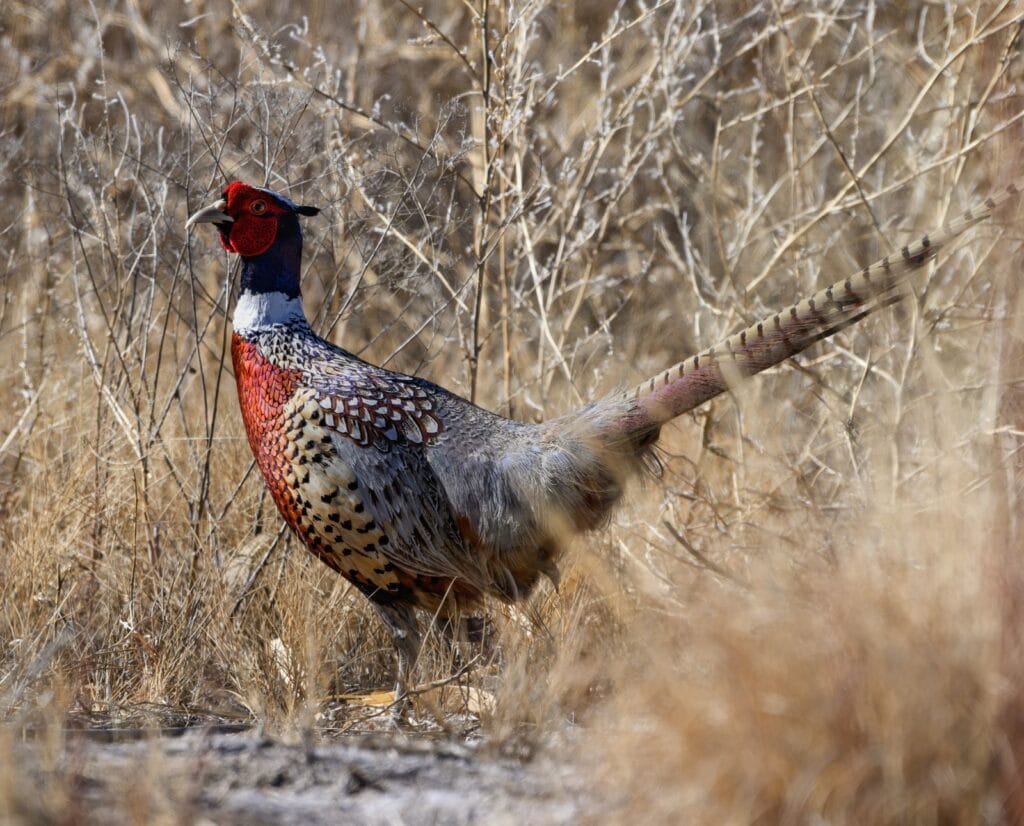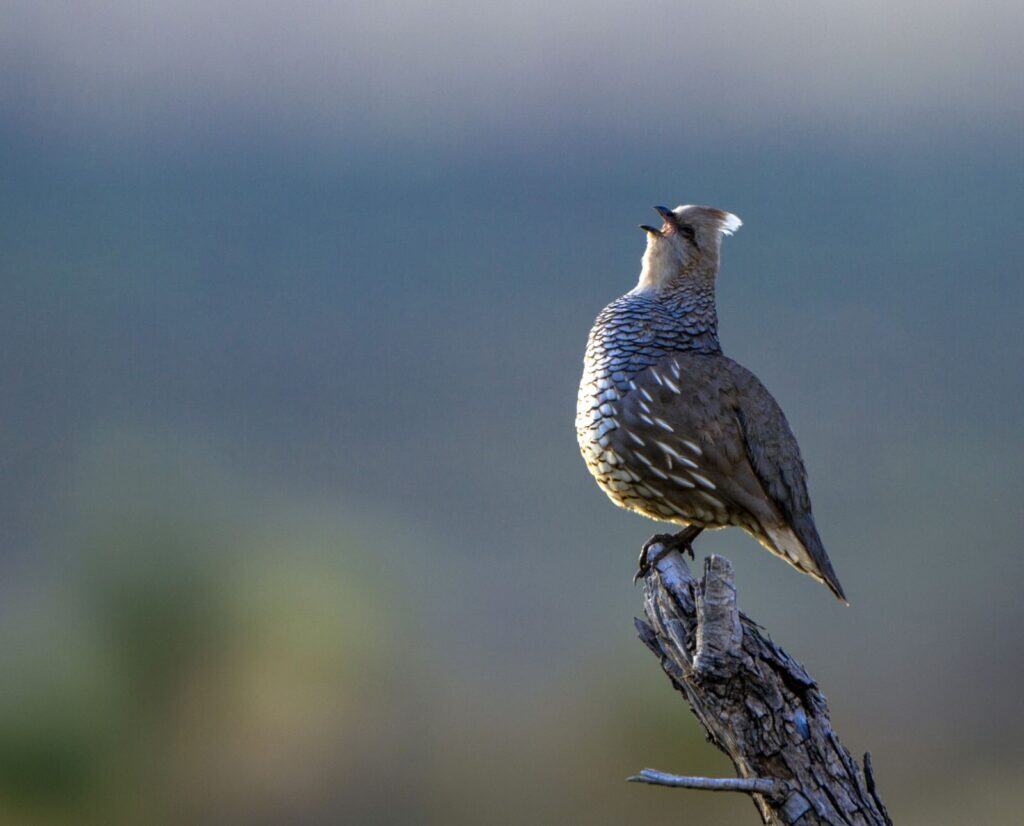Home » Hunting Rules, Licenses, and Seasons » Upland Bird Hunting in Oklahoma – Season Dates, Regulations, Fees, and Species Guide
Upland Bird Hunting in Oklahoma – Season Dates, Regulations, Fees, and Species Guide

Gabby Zaldumbide is Project Upland's Editor in Chief. Gabby was…
Learn about pheasant, bobwhite quail, scaled quail, and other small game hunting opportunities in the Sooner State.
Oklahoma offers upland bird hunting opportunities for bobwhite quail, scaled quail, pheasant, and more on public wildlife management areas and Oklahoma Land Access Program (OLAP) lands. Additionally, the Oklahoma Department of Wildlife Conservation (ODWC) provides season updates for some species before opening day. In 2022, hunters harvested about 43,000 pheasants. According to ODWC upland game biologist Tell Judkins, “In 2024, we are seeing the statewide quail average up by about 48% over 2023… Hunters will likely find areas of good quail numbers where habitat and weather conditions were favorable.” The 2025 season update is forthcoming.
Although quail and pheasant may be commonly found, there is another upland bird that calls Oklahoma home: the lesser prairie-chicken. “Primarily due to large-scale loss of habitat and fragmentation of habitat, their range distribution has been reduced by roughly 85 percent,” states the Natural Resources Conservation Service (NRCS). “About 95 percent of the lesser prairie chicken’s habitat is privately owned, making the land management decisions of producers pivotal to the bird’s success.”
One NRCS initiative is working to protect the remaining lesser prairie-chicken populations: the Lesser Prairie Chicken Initiative (LPCI). Oklahoma is a part of the five-state project working to protect this declining species. Agricultural producers in Oklahoma, Colorado, Kansas, New Mexico, and Texas can choose to voluntarily conserve their properties as part of the LPCI. The benefits of volunteering include financial support, technical assistance, and help planning and implementing effective conservation practices.
Lesser prairie-chickens are often called a “flagship species.” In other words, land management strategies that are implemented to benefit the chicken also benefit other native species. Quail, turkey, songbirds, and pollinators are just a few examples of Oklahoma wildlife that benefit from prescribed burning, native plantings, brush management, and prescribed grazing practices—techniques used to restore and manage prairie chicken habitat.
Oklahoma Upland Bird And Small Game Season Dates And Limits
| Species | Location | Season Dates | Daily/Possession Limits | Notes |
| Quail (Bobwhite and Scaled) | Bobwhite | Nov 8, 2025 – Feb 15, 2026 Seasons on public lands may vary from statewide seasons. Consult the regulations before hunting on public lands. | 10/20 | Possession limit becomes 20 after the first day of the season. |
| Pheasant | Alfalfa, Beaver, Cimarron, Garfield, Grant, Harper, Kay, Major, Noble, Osage, Texas, Woods and Woodward counties; and the portions of Blaine, Dewey, Ellis, Kingfisher and Logan counties north of State Highway 51. | Dec 1, 2025 – Jan 31, 2026 Seasons on public lands may vary from statewide seasons. Consult the regulations before hunting on public lands. | 2/4 | Roosters only. Possession limit becomes 4 after the first day of the season. |
| Dove (Mourning, White-winged, and Eurasian Collared) | Statewide | Sep 1, 2025 – Oct 31, 2025 Dec 1, 2025 – Dec 29, 2025 | 15/45 No limit on collared doves | |
| Woodcock | Statewide | Nov 1, 2025 – Dec 15, 2025 | 3/9 | |
| Rail (Sora and Virginia) | Statewide | Sep 1, 2025 – Nov 9, 2025 | 25/75 | |
| Wilson’s Snipe | Statewide | Sep 27, 2025 – Jan 11, 2026 | 8/24 | |
| Gallinule | Statewide | Sep 1, 2025 – Nov 9, 2025 | 15/45 | |
| Squirrel (Fox and Gray) | Statewide | May 15, 2025 – Feb 28, 2026 | 25/50 combined | Possession limit becomes 50 after the first day of the season. |
| Rabbit (Cottontail, Swamp, and Jackrabbit) | Statewide | Oct 1, 2025 – Mar 15, 2026 | 10/20 cottontail 3/6 swamp 3/6 jackrabbit, except Cimarron, Texas and Beaver counties are 10 daily, 20 in possession after the first day. | Possession limits begin after the first day of the season. |
These dates were last updated on July 9, 2025 and may not reflect any changes since that date. For the most up-to-date information visit the ODWC website.
Quail Hunting in Oklahoma
Two species of quail can be found in Oklahoma: scaled quail and bobwhite quail. “Hunters have harvested an estimated 200,000-500,000 quail annually in Oklahoma over the last 5 years, which consistently ranks Oklahoma in the top three for harvest nationally,” according to the ODWC website.
Scaled quail are predominately found in the Oklahoma panhandle. However, small populations of them can also be found in the state’s southwestern corner. They can be found in areas with mesquite, sunflower, cacti, and other shrubby plant species strewn across short, sparse grasslands.
In Oklahoma, bobwhite quail can be found nearly statewide. Look for areas with cover that is at least three feet tall and features shinnery oak, native grasses, and sand plum motts.
Depending on where you hunt, you may come across quail wing donation boxes. Quail wing donations help state wildlife biologists conduct quail research across Oklahoma. Hunters are encouraged to donate a wing from the quail they shoot during the open season. You can learn more about quail wing donation boxes in this ODWC video.
Quail wing donation boxes can be found at the following management areas:
- Beaver River
- Optima
- Packsaddle
- Cooper
- Kaw
- Drummond Flats
- Canton
- Fort Supply
- Cross Timbers
- Pushmataha
Regarding quail hunting regulations, shooting quail on the ground, also known as pot shooting, is illegal. Quail season runs from November 8, 2025 through February 16, 2026; however, some public lands have different season dates. The quail daily limit is 10 and, after the first day of the season, the possession limit is 20.

Pheasant Hunting in Oklahoma
“A great hunting tradition in Oklahoma is the December 1 pheasant opener in the panhandle. The population of that part of the state swells on the opening day,” states the ODWC. Ring-necked pheasants are predominately found in Oklahoma’s western and northwestern counties. It thrives in the state’s agricultural panhandle.
The pheasant season closes on January 31, 2026. The daily limit is two cocks and, after December 1, the possession limit is four cocks. Note that the regulations state, “Persons who hunt in two states having separate daily limits may not exceed the largest number of birds that can legally be taken in one of the states in which they take birds.”
Squirrel And Rabbit Hunting In Oklahoma
Squirrel and rabbit hunting offers a fun opportunity for upland hunters to take home a mixed bag. Both the eastern fox squirrel and the eastern gray squirrel may be hunted in Oklahoma. Cottontail rabbits, swamp rabbits, and jackrabbits may also be hunted here.
The squirrel season dates are generous and occur between May 15, 2025 and February 28, 2026. Squirrel hunting is open to falconers year round. The daily limit is 25 and the possession limit is 50.
The rabbit season runs from October 1, 2025 through March 15, 2025. However, there is no open season on jackrabbits on lands east of I-35. Each rabbit species has its own bag and possession limits. They are as follows:
- Cottontail: 10 daily, and, after the first day, 20 possession
- Swamp: Three daily and six in possession after the first day
- Jackrabbit: Three daily, then six in possession after the first day except for Cimarron, Texas, and Beaver counties. In those counties, the daily limit is 10 and the possession limit is 20.
Oklahoma Upland Bird Hunting License Fees
| License | Resident | Non-Resident | Notes |
| Annual License | $36 | $209 | |
| Annual Combination Fishing & Hunting License | $53 | – | |
| 3-Year Combination Fishing & Hunting License | $121 | – | |
| 5-Day Hunting License | – | $75 | Not valid for quail hunting |
| Game Bird Permit | – | $100 | Any nonresident hunting game birds on a WMA (this includes any GMA, PHA, WRP, WDU, or WMU), must possess a game bird permit. |
| Land Access Permit | $100 | $200 | Required to access OLAP lands |
These fees were last updated on July 9, 2025 and may not reflect any changes since that date. For the most up-to-date information visit the Oklahoma DWC website.

Oklahoma Blaze Orange Hunting Requirements
Oklahoma requires upland hunters to wear blaze orange or camouflage blaze orange clothing. During any muzzleloader or rifle big game season, you must wear either a hat or an upper garment (shirt, vest, jacket, or other upper-body clothing) that is blaze orange. This regulation is active in any open hunting areas including lands closed to muzzleloader or rifle hunting.
Project Upland always encourages hunters to wear blaze orange, regardless of whether a big game season is active or not.
Dog Training Regulations In Oklahoma
Oklahoma regulations state that “Except as otherwise provided, nothing shall prohibit the year-round pursuit of game (species that can be lawfully hunted with dogs) for dog training… However, unless otherwise provided, no person in pursuit of game with hunting dogs outside the regular harvest season shall possess the means to harvest such game.”
In other words, you can train your dog year-round, but you cannot shoot anything unless that species’ hunting season is open. That said, the exceptions the above text alluded to include:
- Owners, operators, and employees of commercial bird dog training businesses cannot train dogs on ODWC lands.
- You cannot train bird dogs on land managed by Oklahoma’s state wildlife department between June 1 and August 31 annually.
- Citizens cannot train more than three dogs at one time on ODWC lands.
Conservation Organizations In Oklahoma
Oklahoma Quail Forever & Pheasants Forever
Gabby Zaldumbide is Project Upland's Editor in Chief. Gabby was born in Maryland and raised in southern Wisconsin, where she also studied wildlife ecology at the University of Wisconsin-Madison. In 2018, she moved to Gunnison, Colorado to earn her master's in public land management from Western Colorado University. Gabby still lives there today and shares 11 acres with eight dogs, five horses, and three cats. She herds cows for a local rancher on the side.



